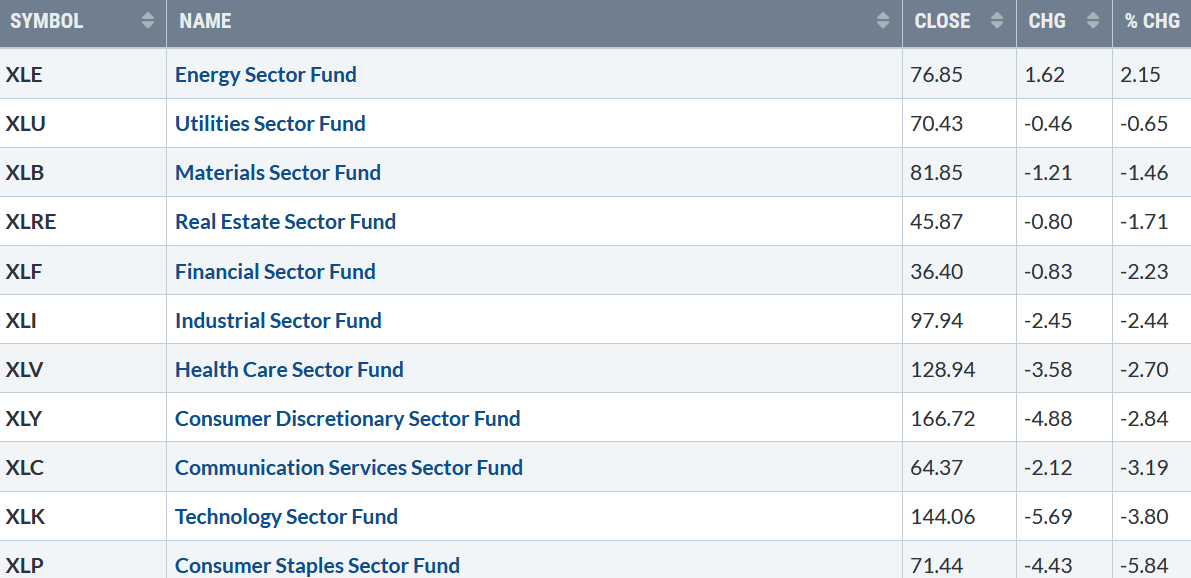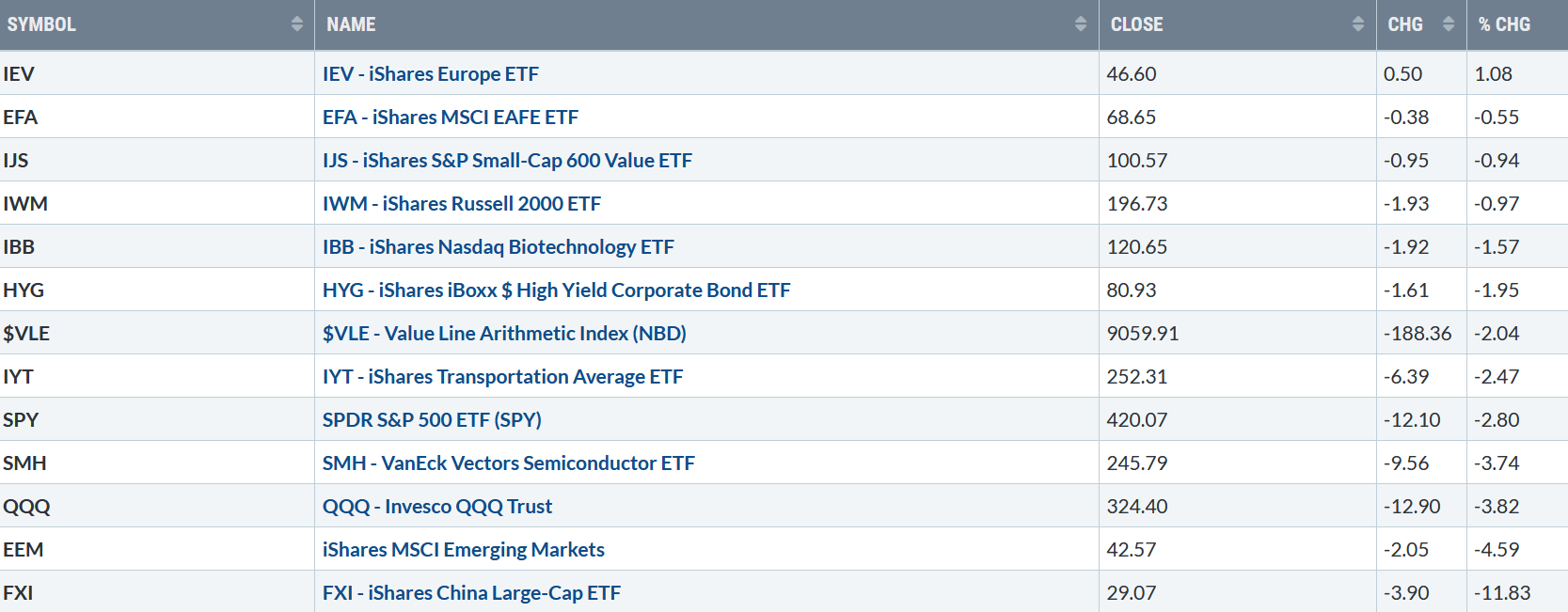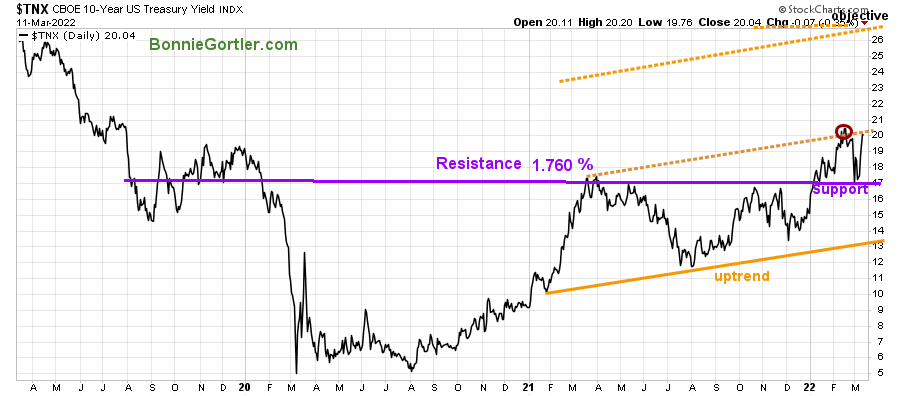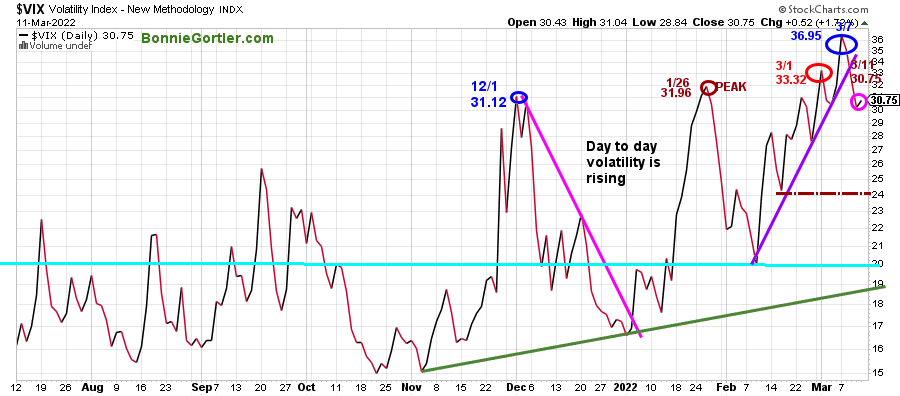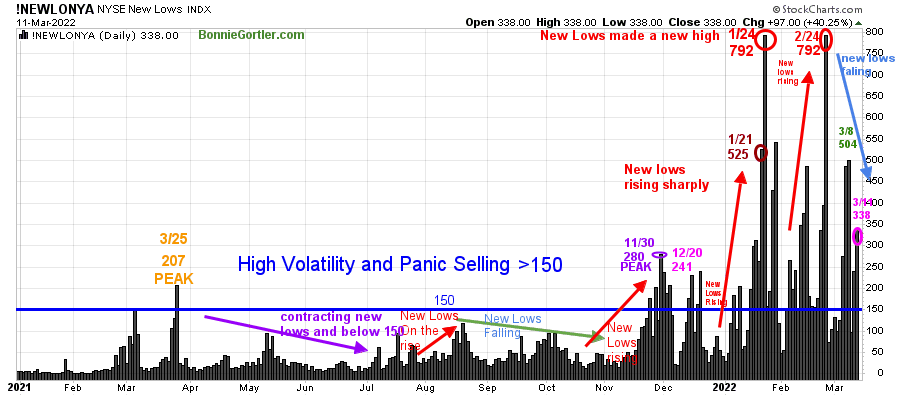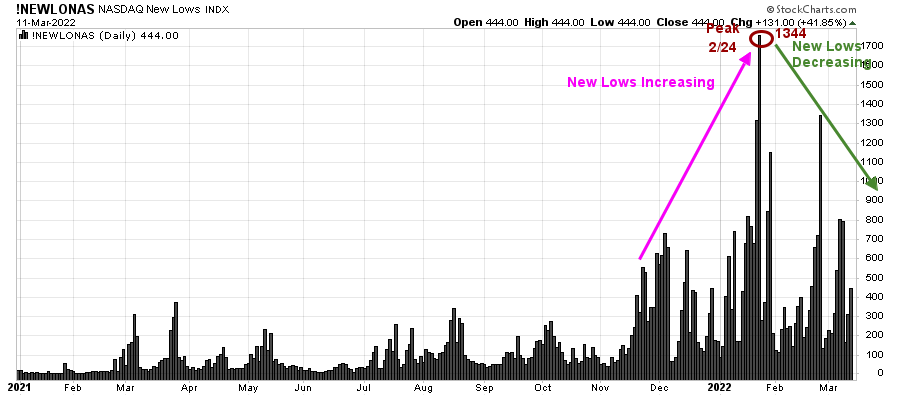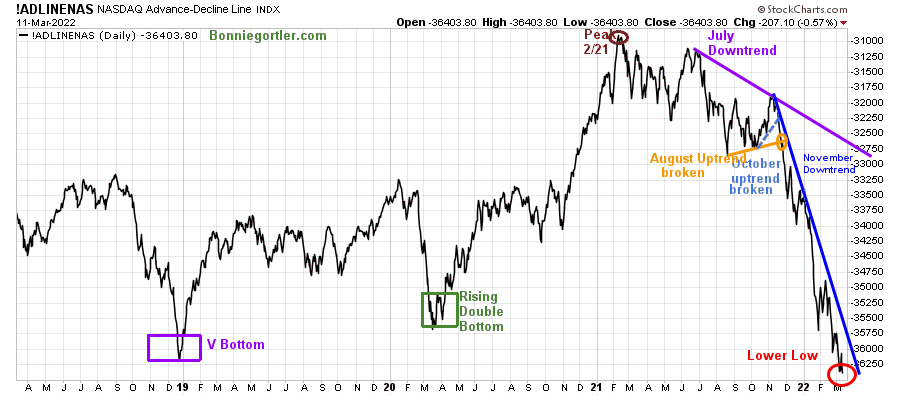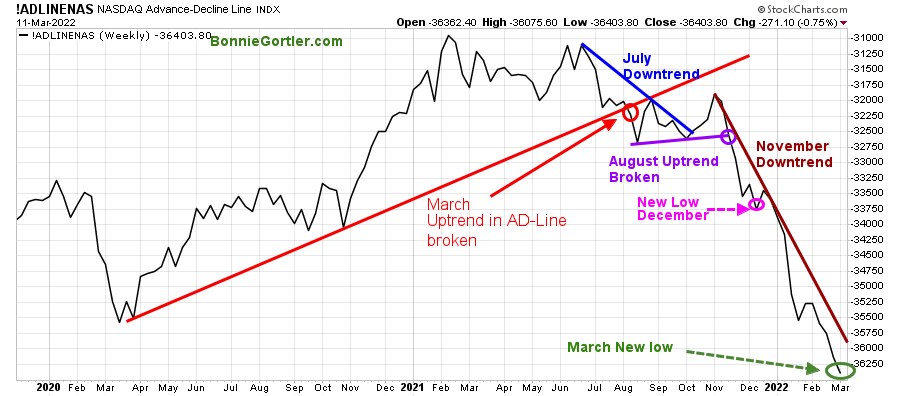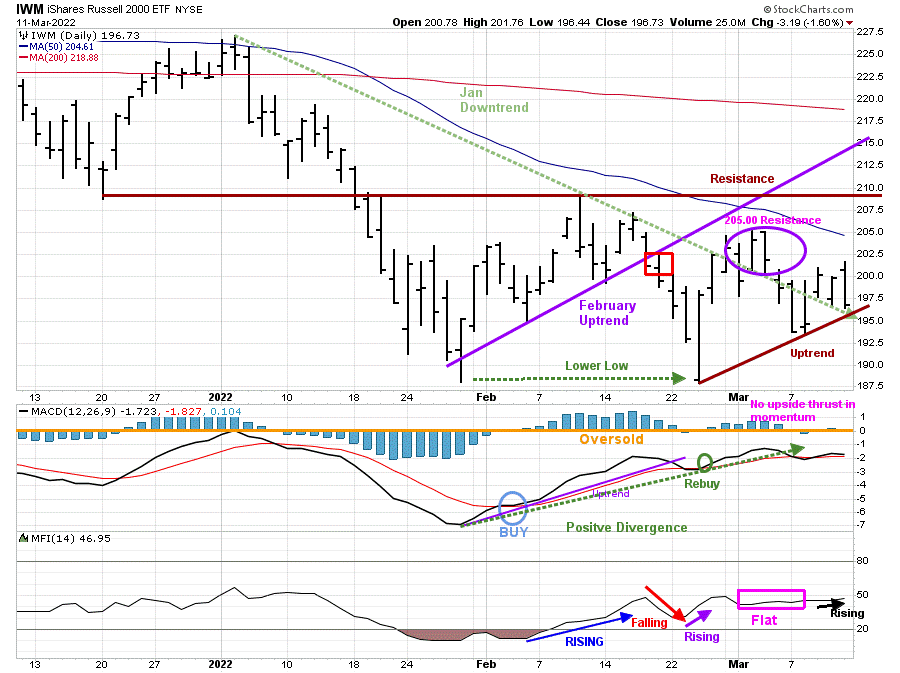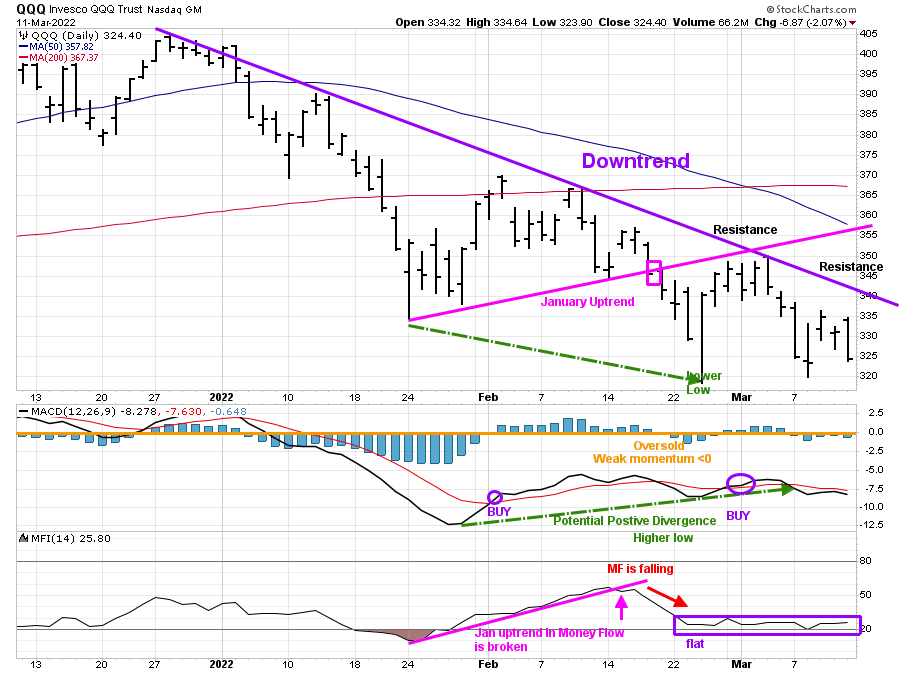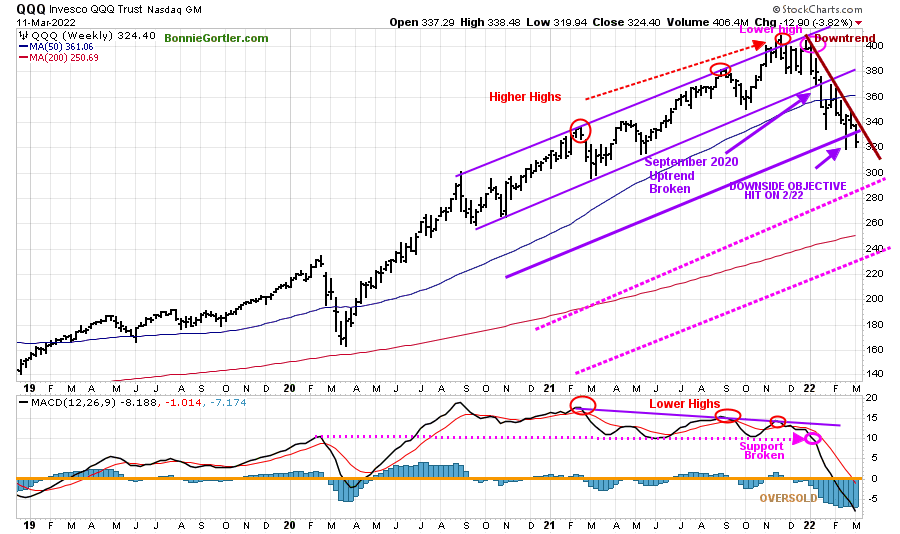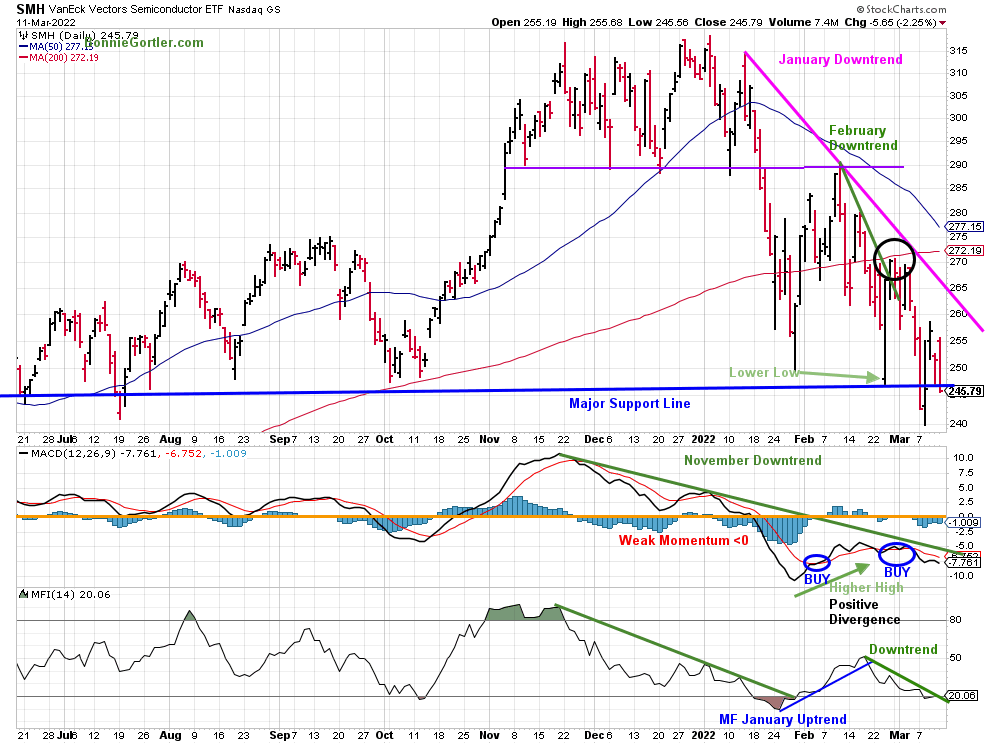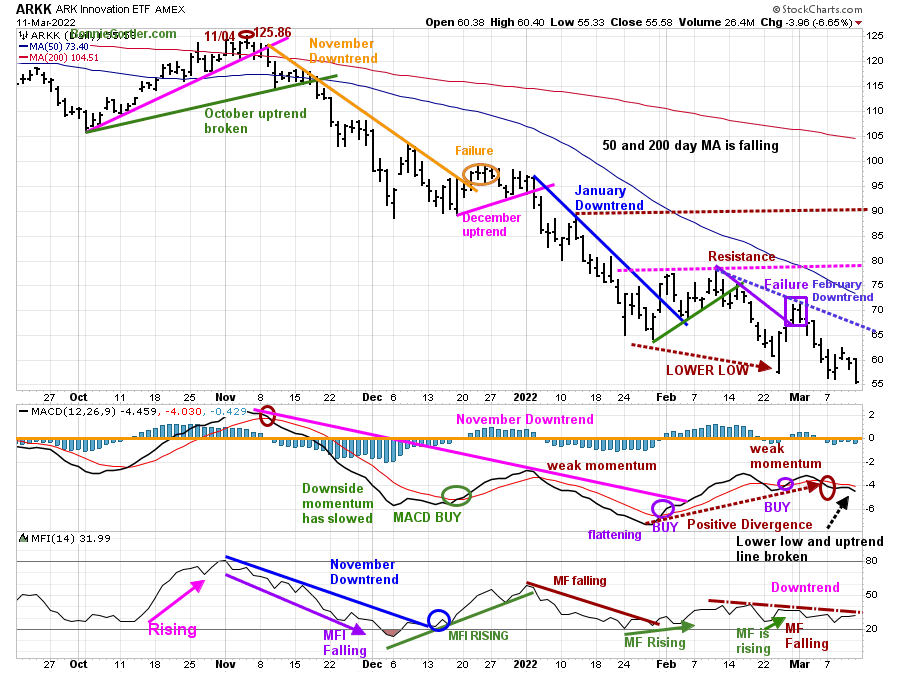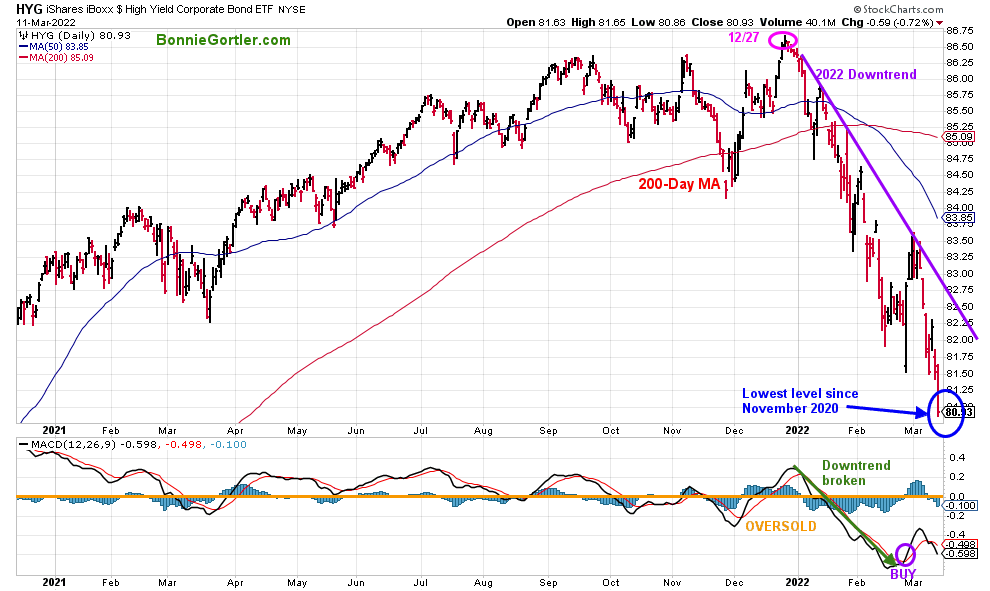The downtrend continued in the major averages, Energy (XLE), the only S&P SPDR sector higher for the week as the (SPY) fell by -2.80%. Technology (XLK) and Consumer Staples (XLP) were the weakest.
3/4/22 – 3/11/22
S&P SPDR Sector ETFs Performance Summary
Source: Stockcharts.com
Figure 2: Bonnie’s Mix of ETFs To Monitor
Performance Summary 3/4/22 – 3/11/22
Source: Stockcharts.com
Fear remains high with the bears in control. The war on Ukraine continued. U.S. and global markets sold off sharply, especially China. Semiconductors and Technology continue to lag as investors shy away from riskier assets.
Figure 3: UST 10YR Bond Yields Daily
Source: Stockcharts.com
The 10-Year U.S. Treasury yields rose sharply last week, closing at 2.004% near the highs for the year. The upside objective remains at 2.7%, while the 5 Year U.S Treasury yields also rose, closing at 1.96%.
Source: Stockcharts.com
Selling pressure continued with the Dow closing lower for its fifth straight week down -1.99%. S&P 500 fell -2.88%, while Nasdaq dropped -3.53%, the weakest of the major averages. The Russell 2000 Index fell -1.06 %, and the Value Line Arithmetic Index (a mix of approximately 1700 stocks) fell -2.04%, not a good week for the bulls.
Weekly market breadth remains negative. The New York Stock Exchange Index (NYSE) had 1123 advances and 2442 declines. The Nasdaq had 2046 advances and 3197 declines. There were 257 New Highs and 936 New Lows on the NYSE and 185 New Highs, and 1419 New Lows on the Nasdaq.
A challenging time for investors, the Dow has been down -7.9%, S&P 500 down -8.2%, and the Nasdaq down -11.4% during the last 30 days.
Figure 4: CBOE Volatility Index VIX
Source: Stockcharts.com
The CBOE Volatility Index ($VIX), a measure of fear, remains above average in 2022.
VIX previously made a high at 31.96 on 1/26 (brown circle), on 3/1 at 33.32 (red circle), and 36.95 on 3/7 (blue circle). VIX was lower to finish the week at 30.75 (pink circle) despite the decline in the major averages.
Day-to-day remains high. Expect the wide intraday swings to continue until there is a close below 24.00.
Figure 5: Daily New York Stock Exchange (NYSE) New Lows
Source: Stockcharts.com
Watching New lows on the New York Stock Exchange is a simple technical tool that helps awareness about the immediate trend’s direction.
New lows warned of a potential sharp pullback, high volatility, and “panic selling” for most of 2022, closing above 150. Learn more about the significance of New Lows in my book, Journey to Wealth, published on Amazon. Here is an excerpt, when new lows are above 150, the market is negative, higher risk, selling is taking place. Sometimes it could be severe, and sometimes on a very nasty day, you can have “panic selling,” and big wild swings (high volatility) to the downside may occur.
As the market sold off in January, New Lows rose sharply, peaking at 792 on 1/24 (red circle) and then contracted but not enough to be in a low-risk zone before rising again on 2/24 at 792, matching the 1/24 peak. However, after a few days of New Lows contracting to below 150, they rose again, after failing to get between 25 and 50, the lower risk zone.
New Lows finished the week at 338 (pink circle), trending down but not yet in a safe buy zone. However, it would be encouraging for the short-term if News Lows contracts below 150 for at least two days and then ultimately falls to between 25 and 50, indicating lower risk. On the other hand, if they remain above 150, expect the decline to continue.
Figure 6: Nasdaq New Lows
Nasdaq New Lows peaked in February at 1344. It’s a positive sign that Nasdaq New Lows decreased as the Nasdaq Index fell.
Figure 7: Daily Nasdaq Advance-Decline Line
Source: Stockcharts.com
The Nasdaq advance-decline line remains in a downtrend in 2022 after peaking in February 2021 (brown circle), followed by failed attempts to make a new high.
After breaking the October uptrend (blue dotted line), the Nasdaq AD-Line made a series of lower highs and lower lows in November, December, and January. Two clear-down trends (blue and purple) remain in effect.
A double bottom pattern potentially making a higher low similar to March 2020 (green rectangle) and the potential V bottom identical to December 2019 (purple rectangle) was developing. However, the AD-Line again made a lower low last week. Until market breadth improves, more near-term weakness is likely.
Figure 8: Weekly Nasdaq Advance-Decline Line
Source: Stockcharts.com
After breaking down in August last year, the Nasdaq Weekly AD-Line made a few attempts to form a bottom but failed, continuing to make lower lows In January, February, and March.
Attempted rallies have been weak. Stringing two days of gains together have been rare; the November downtrend remains, and selling continues.
Figure 9: Daily iShares Russell 2000 (IWM) Price (Top) and 12-26-9 MACD (Middle) and Money Flow (Bottom)
Source: Stockcharts.com
The top portion of the chart is the daily iShares Russell 2000 Index ETF (IWM), the benchmark for small-cap stocks, with a 50-Day Moving Average (MA) (blue line) and 200-Day Moving Average (MA), that traders watch and use to define trends. A false breakout occurred in November 2021 in IWM after being in a nine-month trading range.
The February uptrend and support at 200.00 was penetrated on 2/18 (red rectangle) and remained below its 50 and 200-Day Moving Average. In March, IWM failed to close over resistance at 205.00 and turned lower, a false breakout of the January downtrend (green dotted line).
Short-term resistance remains at 205.00, 207.50, and 210.00.
The trend remains down. IWM fell -0.97% for the week closing at 196.73, not as weak as the S&P 500 and slightly above the February downtrend, a positive sign. If IWM can hold and be stronger than the S&P 500, IWM could be the catalyst to ignite the market higher. On the other hand, if IWM breaks the uptrend, IWM is likely to test the February low and then start a new down leg toward the downside objective at 178.00.
MACD (middle chart) has not shown much upside momentum in 2022, failing to get above 0. The MACD positive divergence remains and a rebuy but no strength in price. A lower low in MACD would be bearish.
Money Flow (lower chart) has been changing direction quickly since February was flat, and now a tiny uptick. However, nothing significant at his time. More patience and an upside reversal are needed to confirm a shift that investors are willing to buy.
Figure 10: Daily Invesco QQQ Trust (QQQ) Price (Top), and 12-26-9 MACD (Bottom)
Source: Stockcharts.com
The chart shows the daily Invesco QQQ, an exchange-traded fund based on the Nasdaq 100 Index with its 50-Day Moving Average and 200-Day Moving Average. QQQ accelerated after breaking the January uptrend (pink rectangle), penetrating the January lows and falling through the first downside objective at 330.00, not reaching the lower objective of 310.00 before reversing higher.
QQQ stalled at 351.00 resistance in early March and turned lower. Last week QQQ continued the downtrend breaking below support at 355.00 mentioned in the Market update 3/4/22, closing at 324.40, down -3.82% remaining below its 50 and 200 Day MA.
Resistance is at 340.00, followed by 351.00, 355.00, and 370.00.
Support is at 320.00, and a close below 320.00, will likely trip the sell stops, accelerating the decline.
The lower chart is MACD (12, 26, 9), a measure of momentum. MACD is on a buy, falling below 0 but not enough upside momentum to reach 0, not a good sign. A positive divergence has formed, and repeat buys in MACD; however, no rise remains concerning.
Money Flow remains in a sideways trading range after breaking the December uptrend.
Until QQQ closes above 340.00 and then 351.00 with MACD and Money Flow rising, the risk of the correction persists.
Intermediate-Term Trend Remains Down
Figure 11: Weekly Invesco QQQ Trust (QQQ) Price (Top), and 12-26-9 MACD (Bottom)
Source: Stockcharts.com
The top chart shows the weekly Invesco QQQ Trust (QQQ) making higher highs peaking in November 2021 (red circles) but failed to make a new high in December and then turned down. The September 2020 uptrend broke down seven weeks ago, giving a downside objective to 325.00 (lower channel), which hit 2/22.
A meager rally attempt occurred after. If QQQ doesn’t turn up immediately and the decline begins to accelerate, the new downside objective is 285.00, followed by 235.00.
MACD (lower chart) remains on a sell after making lower highs and breaking below support held since February 2020 (pink dotted line), implying weak underlying momentum. MACD is deeply oversold, below 0, below the March 2020 low in an area where good buying opportunities develop. Once the price stops falling, be alert for downside momentum to subside, and MACD begins to flatten, followed by a turn up for a safer entry.
Figure 12: Van Eck Semiconductors (SMH) Daily Price (Top), 12-26-9 MACD (Middle) and, Money Flow (Bottom)
Source: Stockcharts.com
Support was broken in late January, and SMH fell sharply. SMH briefly penetrated the February downtrend (green line) (but did not generate any upside strength (black circle) to break the January downtrend (pink line).
SMH fell sharply for the second week in a row, closing at 245.79 down -3.74%.
Support is at 240.00, resistance is at 255.00, followed by 265.00 and 270.00.
MACD (middle chart) generated a buy (green circle) in February from a deeply oversold level. SMH rallied, but MACD did not get above 0. In late February, a positive divergence formed, but the rally was short-lived before SMH fell, not gaining enough momentum to break the November downtrend (green line), confirming the reentry. SMH
Money Flow (lower chart) had a few turn-ups but no upside momentum and remains in a downtrend (green line).
For a potential sustainable rally in the future, the MACD January downtrend first needs to be broken, and SMH closes above 255.00. However, if SMH closes below 240.00, the decline could accelerate.
Figure 13: Daily ARK Innovation (ARKK)
Source: Stockcharts.com
ARK Innovation (ARKK) is an actively managed ETF by Cathie Wood that seeks long-term growth and is highly volatile. ARKK broke its September short-term downtrend (brown line) in October 2021.
Downside momentum temporarily subsided where ARKK broke its February downtrend (purple line), failing to close above resistance (pink dotted line). Afterward, rally attempts failed, and ARKK made lower lows creating a new downtrend (blue dotted line).
ARKK selling pressure continued last week, closing at 55.58, down -6.65% below support. Resistance is at 57.00, followed by 65.00, 72.50, and 77.50.
MACD failed to get above 0 since November 2021, implying internal weakness. However, MACD’s recent repeat buy signal and positive divergence, which usually is a bullish pattern, did not materialize. Instead, MACD made a lower low, implying increased downside momentum.
Money flow (lower chart) remains in a downtrend (brown dotted line). I would like to see Money flow rise above the February high reading to confirm that investors are stepping in to buy.
ARKK remains high-risk and volatile, with the bears solidly in control. With its high volatility, know that a 10% reversal to the upside in one day can occur at any time.
Downside pressure continues in Hi Yield Bonds
Figure 14: I Shares Hi Yield Corporate Bond (HYG)
Hi-Yield Bonds (HYG) peaked on 12/27/21, appeared to stabilize in late February, but reversed lower, and are now at their lowest level since November 2020 (blue circle). Continued weakness in Hi Yields is bearish for U.S. Equities.
Summing Up:
The Russian invasion of Ukraine continues. Concerns about inflation weigh on U.S. equities. For now, the risk is high, of a further decline possible even with deeply oversold momentum oscillators from where historically major buying opportunities tend to occur. Being oversold creates opportunity but is not a buy signal in itself. It’s essential to see an improvement in market breadth and the major averages to begin to stabilize early in the week and then reverse higher, breaking the short-term downtrends that are in effect for a sustainable rally.
Remember to manage your risk, and your wealth will grow.
If you liked this article, you will love my Free Grow and Sustain Your Wealth Report. Get it here:
See more charts. I invite you to my FB group Wealth Through Market Charts.
I would love to hear from you. If you have any questions or comments or would like to talk about the market, click here.
Disclaimer: Although the information is made with a sincere effort for accuracy, it is not guaranteed that the information provided is a statement of fact. Nor can we guarantee the results of following any of the recommendations made herein. Readers are encouraged to meet with their own advisors to consider the suitability of investments for their own particular situations and for determination of their own risk levels. Past performance does not guarantee any future results.


